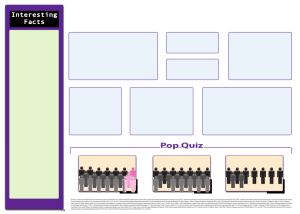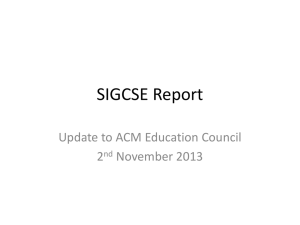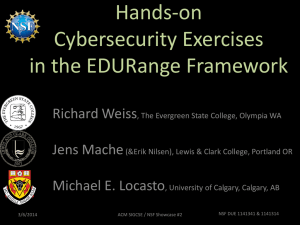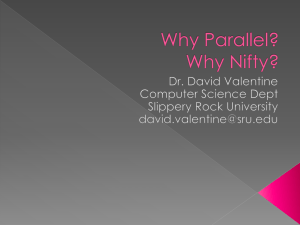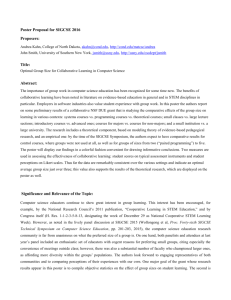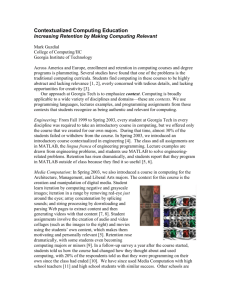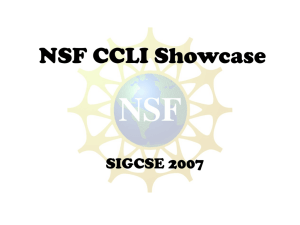ppt presentation - University of Washington
advertisement
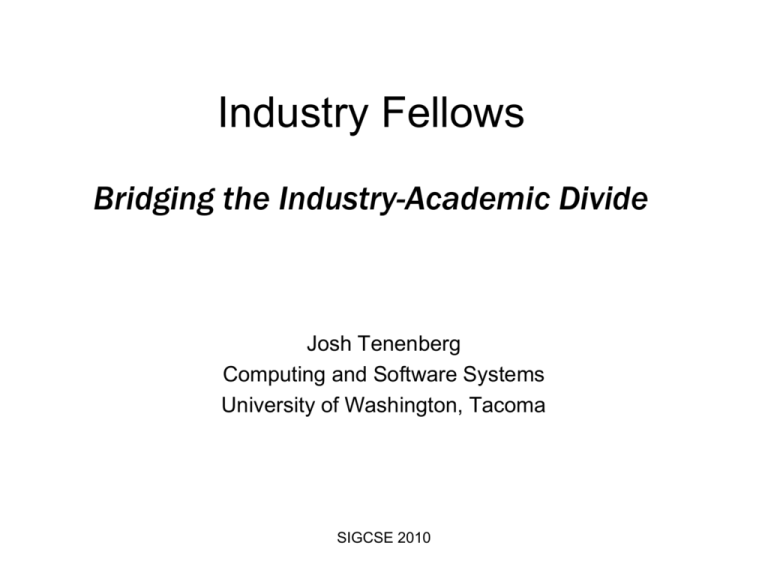
Industry Fellows Bridging the Industry-Academic Divide Josh Tenenberg Computing and Software Systems University of Washington, Tacoma SIGCSE 2010 SIGCSE 2010 The Industry Fellows Model SIGCSE 2010 Outline • The Video • What does pairing a teacher and industry professional enable? • Impact on students • Design Principles SIGCSE 2010 What is enabled? SIGCSE 2010 Supervised Sandbox: Requirements interview with “client” SIGCSE 2010 “When you talk with clients, you cannot design ... talking about the design of the system will lead you to not ask things you should.” “No one else will write the requirements.” “Document everything you talk about with [the client]” “What they say and what they want are two different things.” SIGCSE 2010 Example Critique By Jake Knapp, an Interaction Designer at Google, commenting on a student design http://www.youtube.com/watch?v=1MywEsEizTg Impact on students Indicate how the participation of the Industry Fellow impacted your: ++ + 0 - -- 6 3 1 0 0 7 1 2 0 0 engagement in the course 5 activities inside and out of class learning of the material in this 7 course 2 3 0 0 3 0 0 0 motivation to do coursework motivation to attend class SIGCSE 2010 1. “Compared to other courses in the Institute of Technology at UW Tacoma, what difference did it make having the industry fellow as part of the teaching team?” 2. “How has interaction with the industry fellow affected the design and execution of your final project?” SIGCSE 2010 • Legitimization of the course “[The industry fellow's] presence helped us to think of our project as serious work rather than a practice exercise that simply simulated the real work.” • Connecting classroom to world “The industry fellow ... helped tie in some of the key concepts that we would need to learn and be conscious of for work outside of an academic setting.” • A higher standard of performance “The feedback he was able to give us on our milestones was well-grounded, and the fact that he didn't hold his punches made us more determined to work hard.” “I feel that since we were going to be presenting our project to an industry professional, we wanted to increase the quality of the project.” • Students value academic and practical knowledge “Having a representative from the industry provides a much needed alternate perspective. We have been able to get both the research and experimentation view alongside the practical hands on perspective.” SIGCSE 2010 Design Principles • Working together on curriculum review, planning and enactment of a course related to the professional's expertise • Regular interaction between industry fellow, students, and teacher during academic term • Division of labor to exploit what each does best • Flexible to adapt to different contexts • Sustainable time commitment for both faculty member and industry fellow SIGCSE 2010 Photo references • Google Kirkland office photo: http://seattletimes.nwsource.com/ABPub/20 08/05/05/2004393664.jpg • UW Tacoma photo: www.djc.com/special/construct99/10d.jpg • “Shop” photo: http://grcimagenet.grc.nasa.gov/grcdigital images/1998/1998_02798L.JPG SIGCSE 2010 Thanks to … • The IF’s: Adam Barker, Jake Knapp, Beth Whitezel • Students in TCSS 452, winter 2009 and 2010 and students in TCSS 360 winter 2010 • Orlando Baiocchi, Director of the Institute of Tech@UWT • UWT Institute of Technology Advisory Board • UWT Chancellor’s Fund: for replication and external eval SIGCSE 2010 This work is licensed under the Creative Commons Attribution-Noncommercial-No Derivative Works 3.0 United States License. To view a copy of this license, visit http://creativecommons.org/licenses/by-ncnd/3.0/us/ or send a letter to Creative Commons, 171 Second Street, Suite 300, San Francisco, California, 94105, USA. SIGCSE 2010 Professional practitioners moonlighting as part-time teachers • Assumes the transmission model: domain knowledge is all that matters • Discounts educator expertise: pedagogical knowledge, pedagogical content knowledge, local knowledge, ... SIGCSE 2010 Guest speakers from industry • As above: the transmission model and discounting educator expertise • Most practice is tacit, so only a fraction can be verbalized in a talk • No feedback to students on their work • Decontextualized from the classroom: does not bridge the gap from university to industry • Little to no understanding of the pragmatics of specific higher education institutions SIGCSE 2010 Team teaching • Discounts professional practitioner expertise • Socializes students into a community of academics SIGCSE 2010 Student coops/internships • Assumes the socio-cultural model • Difficult to instantiate at a number of institutions • Experience varies considerably from one student to next • Few opportunities to integrate academic knowledge, including reflection on experience SIGCSE 2010 Industry advisory boards • Industry input is at the wrong “level”: – On programs as wholes, not individual courses – No feedback to students on their work • Decontextualized from the classroom: does not bridge the gap from university to industry SIGCSE 2010 In a recent large-school study of engineering programs sponsored by the Carnegie Foundation for the Advancement of Teaching, the authors propose that professional practice shoud be at the center of engineering curricula. “[I]f students are to be prepared to enter new-century engineering, the center of engineering education should be professional practice, integrating technical knowledge and skills of practice. ... “faculty need to make clear what expert practice looks like, modeling or otherwise making visible both thinking and doing.” Both the National Research Council, in their report How People Learn and the Carnegie Foundation's Preparation for the Professions Program “stress the need for ... teachers to workwith practicing professionals as they create robust strategies for teaching and learning in the various professional disciplines“ [8], with similar sentiments echoed by the National Academy of Engineering. SIGCSE 2010 Design Brainstorm SIGCSE 2010 SIGCSE 2010 SIGCSE 2010 Why is Industry Fellows novel? compared to ... • Student coops/internships • Guest speakers from industry • Professional practitioners moonlighting as part-time teachers • Industry advisory boards SIGCSE 2010 • Student coops/internships • Guest speakers from industry • Professional practitioners moonlighting as part-time teachers • Industry advisory boards SIGCSE 2010 Folk pegagogy, not learning research “[In this model] what is important about education is the corpus of facts that has been collected about a particular subject. ... For learning to occur, knowledge has to enter learners’ minds, which requires that it be transmitted from the outside world (e.g. from a teacher or book). ...” Bruce Torff, “Tacit Knowledge in Teaching” in Sternberg and Horvath (eds.) Tacit Knowledge in Professional Practice, Lawrence Erlbaum Associates, 1999. SIGCSE 2010 Learning research, not folk pedagogy “ ‘to learn’ means to participate more successfully in the collective practices that define particular ways of knowing as recognized by various communities.” Hickey and Anderson, “Situative approaches to student assessment”, 2007 “the mastery of knowledge and skill requires newcomers to move toward full participation in the sociocultural practices of a community.” Lave and Wenger, Situated Learning: Legitimate Peripheral Participation, 1991 SIGCSE 2010 SIGCSE 2010 What are the philosophical assumptions built into Industry Fellows? Replaces a transmission model of learning with a sociocultural model. SIGCSE 2010 The Transmission model of learning SIGCSE 2010 The sociocultural model of learning SIGCSE 2010 Different social and material worlds SIGCSE 2010 Practitioners and higher-ed faculty inhabit different worlds SIGCSE 2010 The Industry Fellows program bridges the gap SIGCSE 2010
